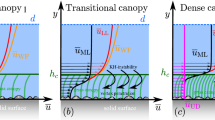Abstract
The evaluation of longitudinal dispersion in aquatic canopies is necessary to predict the behavior of dissolved species and suspended particles in marsh and wetland systems. Here we consider the influence of canopy morphology on longitudinal dispersion, focusing on transport before constituents have mixed over depth. Velocity and longitudinal dispersion were measured in a model canopy with vertically varying canopy density. The vertical variation in canopy morphology generates vertical variation in the mean velocity profile, which in turn creates mean-shear dispersion. We develop and verify a model that predicts the mean-shear dispersion in the near field from morphological characteristics of the canopy, such as stem diameter and frontal area. Close to the source, longitudinal dispersion is dominated by velocity heterogeneity at the scale of individual stems. However, within a distance of approximately 1 m, the shear dispersion associated with velocity heterogeneity over depth increases and eclipses this smaller-scale process.
Similar content being viewed by others
Abbreviations
- A :
-
Cross-sectional area
- a :
-
Volumetric frontal area density
- C D :
-
Drag coefficient
- d :
-
Stem diameter
- D z :
-
Vertical turbulent diffusion coefficient
- f :
-
Function
- g :
-
Gravitational constant
- h :
-
Water depth
- i :
-
1 for upper canopy layer, 2 for lower layer
- K :
-
Dispersion coefficient
- n :
-
Stem density
- O :
-
Order of magnitude
- Q :
-
Volumetric flow rate
- Re d :
-
Stem Reynolds number
- t :
-
Time
- u :
-
Time-averaged fluid velocity
- \(\langle u\rangle \) :
-
Time- and horizontally averaged fluid velocity
- U :
-
Time- and spatially averaged fluid velocity
- x :
-
Distance in the direction of flow
- y :
-
Transverse coordinate
- z :
-
Height above bed
- β:
-
Scale constant
- Δh :
-
Effective vertical cloud width
- \(\Delta \langle u\rangle\) :
-
Difference between maximum and minimum velocities
- η:
-
Surface elevation
- ν:
-
Kinematic viscosity
- σ x :
-
Concentration standard deviation
- \(\sigma_x^2\) :
-
Spatial concentration variance
References
Stage SA (2004) Determination of acute exposure guideline levels in a dispersion model. J Air Waste Manage Assoc 54:49–59
Fonseca DM, Hart DD (1996) Density-dependent dispersal of black fly neonates is mediated by flow. Oikos 75:49–58
Middleton B (2000) Hydrochory, seed banks, and regeneration dynamics along the landscape boundaries of a forested wetland. Plant Ecol 146:169–184
Finelli CM (2000) Velocity and concentration distributions in turbulent odor plumes in the presence of vegetation mimics: a flume study. Mar Ecol Prog Ser 207:297–309
Leonard LA, Luther ME (1995) Flow hydrodynamics in tidal marsh canopies. Limnol Oceanogr 40:1474–1484
Lightbody AF, Nepf HM (2006) Prediction of velocity profiles and longitudinal dispersion in emergent salt marsh vegetation. Limnol Oceanogr 51:218–228
Mazda Y, Wolanski E, King B, Sase A, Ohtsuka D, Magi M (1997) Drag force due to vegetation in mangrove swamps. Mangroves Salt Marshes 1:193–199
Ayotte KW, Finnigan JF, Raupach MR (1999) A second-order closure for neutrally stratified vegetative canopy flows. Boundary-Layer Meteorol 90:189–216
White BL, Nepf HM (2003) Scalar transport in random cylinder arrays at moderate Reynolds number. J Fluid Mech 487:43–79
Lightbody AF (2004) Field and laboratory observations of small-scale dispersion in wetlands. MS thesis, Mass. Inst. of Tech., Cambridge, Massachusetts
White FM (1991) Viscous fluid flow. McGraw-Hill, New York
Struve J, Falconer RA, Wu Y (2003) Influence of model mangrove trees on the hydrodynamics in a flume. Estuar Coast Shelf Sci 58:163–171
Koch DL, Ladd AJC (1997) Moderate Reynolds number flows through periodic and random arrays of aligned cylinders. J Fluid Mech 349:31–66
Nepf HM (1999) Drag, turbulence, and diffusion in flow through emergent vegetation. Water Resour Res 35:479–489
Stone BM, Shen HT (2002) Hydraulic resistance of flow in channels with cylindrical roughness. J Hydraul Eng 128:500–506
Fischer HB, List EJ, Koh RCY, Imberger J, Brooks NH (1979) Mixing in inland and coastal waters. Academic Press, San Diego
Nepf HM, Sullivan JA, Zavistoski RA (1997) A model for diffusion within emergent vegetation. Limnol Oceanogr 42:1735–1745
Mauri R, Haber S (1986) Applications of Wiener’s path integral for the diffusion of Brownian particles in shear flows. SIAM J Appl Math 46:49–55
White BL (2006) Momentum and mass transport by coherent structures in a shallow vegetated shear flow. Ph.D. thesis, MIT, Cambridge, Massachusetts
Ikeda S, Kanazawa M (1996) Three-dimensional organized vortices above flexible water plants. J Hydraul Eng 122:634–640
Neumeier U, Ciavola P (2004) Flow resistance and associated sedimentary processes in a Spartina maritima salt-marsh. J Coast Res 20:435–447
Vermaat JE, Santamaria L, Roos PJ (2000) Water flow across and sediment trapping in submerged macrophyte beds of contrasting growth form. Arch Hydrobiol 148:549–562
Harii S, Kayanne H (2003) Larval dispersal, recruitment, and adult distribution of the brooding stony octocoral Heliopora coerulea on Ishigaki Island, southwest Japam. Coral Reefs 22:188–196
Moore P, Crimaldi J (2004) Odor landscapes and animal behavior: tracking odor plumes in different physical worlds. J Mar Sys 49:55–64
Author information
Authors and Affiliations
Corresponding author
Rights and permissions
About this article
Cite this article
Lightbody, A.F., Nepf, H.M. Prediction of near-field shear dispersion in an emergent canopy with heterogeneous morphology. Environ Fluid Mech 6, 477–488 (2006). https://doi.org/10.1007/s10652-006-9002-7
Received:
Accepted:
Published:
Issue Date:
DOI: https://doi.org/10.1007/s10652-006-9002-7




